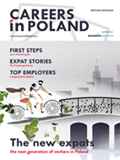Which jobs in Poland are most endangered by AI?

Editor

Photo by Cash Macanaya on Unsplash
related articles
As artificial intelligence (AI) advances, the impact of technology on the labor market is becoming increasingly noticeable. With this in mind, the research conducted by the Polish Economic Institute’s (pl. Polski Instytut Ekonomiczny) sheds light on how AI’s integration into the workplace will have far-reaching effects across occupations and demographics.
Who’s most affected by AI?
The study identifies 20 professions most susceptible to AI disruption, encompassing roles like financiers, lawyers, government officials, and programmers. These specialized fields, where tasks are often repetitive or rely heavily on data and analytical processing, are ripe for automation and AI integration.
Across Poland, this accounts for around 3,68 million jobs, or roughly 20% of the workforce.
On the opposite end of the spectrum, sectors that involve manual labor or low AI-automatable tasks, such as agriculture and construction, have significantly lower AI exposure. These less vulnerable fields employ about 1,66 million workers, illustrating a stark contrast in how AI’s reach varies across professions.
Women face greater AI impact
An interesting aspect of PIE’s research is the gender difference in AI exposure. Although more men are employed overall in Poland, the majority of workers in the 20 most AI-affected professions are women. Out of 3,68 million people in these fields, 2,16 million are women, compared to 1,53 million men.
This discrepancy can be partly explained by the higher educational qualifications required in these professions, which are more common among women in Poland. Additionally, women are less likely to work in physical, hands-on roles, such as in construction or agriculture, which are among the least impacted by AI.
In terms of percentages, 28% of all working women are in roles heavily exposed to AI, compared to 17% of men. This implies that AI-related disruptions could disproportionately impact women, raising questions about how this gendered vulnerability might shape labor policies and workforce protections.
What industries are most vulnerable to AI?
Certain economic sectors are poised to experience greater AI impacts than others. Unsurprisingly, the financial and insurance industries top this list. In these sectors, AI applications like process automation, data analytics, and predictive modeling are already transforming business practices, signaling that employees in these industries may need to adapt to AI-driven changes sooner rather than later.
The technical fields, as well as education, also show significant exposure to AI. These sectors benefit from AI applications in data analysis and administrative automation but may also see job roles change or disappear as these technologies become standard.
Interestingly, the IT sector, often seen as the “home turf” for AI, ranks fourth in general AI exposure. However, when considering large language models (LLMs) specifically, IT rises to third place, reflecting the increasing relevance of AI-driven language and code generation tools in software and IT services.
Which professions are most AI resilient?
By contrast, sectors like agriculture, construction, and food services see minimal AI exposure. The manual and often unpredictable nature of jobs in these industries makes them less suitable for automation, suggesting that workers in these sectors may remain relatively insulated from AI-driven disruption in the near future.
Do we welcome or fear AI in the labor market?
While AI is steadily advancing, Poles are divided on whether this is a positive development for the job market.
According to PIE, around 25,8% of respondents believe that AI will create more jobs, pointing to optimism about the potential for AI to stimulate innovation and generate new employment opportunities.
However, a larger segment, 33,4%, expresses concern that AI may actually reduce job availability. This sentiment likely reflects apprehension about potential job losses, particularly in administrative, clerical, and analytical roles that AI could streamline or automate entirely.
AI – in, humans – out?
The impact of AI on jobs is a complex issue, presenting both challenges and opportunities for workers and employers alike. For those in professions most endangered by AI, adaptability is crucial.
Upskilling in areas that AI cannot easily replicate – such as creative problem-solving, interpersonal communication, and strategic planning – could prove essential for career resilience.
That is, if or until AI becomes fully capable of taking care of these processes, as well.
At the same time, policymakers and businesses play crucial roles in supporting workforce transitions. The employers need to ensure that after the cost-cutting, hidden under the misgiving banner of “process optimization”, there is something left for us, puny humans, to actually do for a living.
Sources:
PIE, “Co piąty pracownik w Polsce wykonuje zawód najbardziej wystawiony na wpływ AI”. 2024












